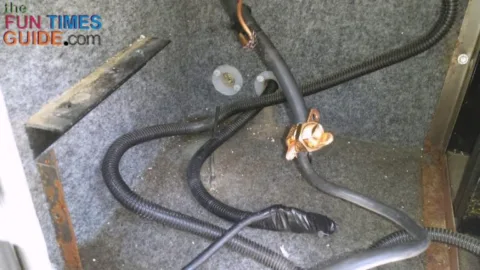Not all things last forever. So it goes for the RV converter that came as standard equipment in my 1993 Diesel Pusher.
It was a top-of-the-line RV at the time, and it had a top-of-the-line electrical system to run it.
But soon after I purchased my well-aged coach, the converter — which is hefty enough to handle the load of everything in the RV (minus the air conditioners) — gave up the ghost.
RVs today are equipped with converters as standard equipment. The converter not only changes A/C power to D/C power, it also act as a battery charger. This means when you are plugged into a 120-volt power source, you are able to run all your fixtures/appliances that need 12-volt D/C power without drawing your RV batteries down. In fact, while you are plugged into the 120-volt power source, you are actually charging your deep cycle RV batteries at the same time! —Extreme RV Guy
The Cost To Repair vs. Replace
Although this top-of-the-line Heart Interface Inverter was the cream of the crop back in 1993, having it repaired or replaced was likely to cost me a bundle.
This thing is just plain heavy — so the shipping charges alone would be hard on the wallet.
The value of sending it in for repairs was determined by what I intended to run with it. After careful consideration, I decided that beyond running the flat screen TV and a few lights, this RV inverter was likely to spend much of its life sitting silent in the storage bay where it’s mounted.
I Replaced It With A 1750-Watt Inverter
It just seemed more practical to make use of my existing 1750-watt inverter and call it good.
Inverters are not standard equipment. Rather, inverters are an add-on accessory. If you choose to equip your RV with an inverter you will be drawing & relying on your 12-volt D/C power supply (in other words your deep cycle battery). Something to keep in mind when considering which inverter is right for you is the load you will be placing on the inverter. For example the load required to charge a cell phone will be much less than the load required to run a microwave oven. If you plan on inverting your D/C power to A/C power you may want to consider solar panels. It doesn’t take long to draw down your RV batteries when inverting considering the inverter converts the DC power to AC power at a ratio of 10 to 1! Knowing that for every 1 amp needed to run the appliance approximately 10 amps is drawn from the battery, how long your RV battery will last all comes down to your overall battery capacity. —Extreme RV Guy
I Added A New Remote Control Panel Too
My biggest concern was the lack of a remote on/off switch panel for this inverter — which is also 20 years old.
I found a remote control panel and wiring for about $25 on eBay:
It was a bargain, considering a new Heart Inverter would easily run over $1,000!
How I Installed The Replacement RV Inverter
It was awkward to get at the heavy battery cables coming out the back side of the old RV converter.
With some maneuvering, I was eventually able to use a hacksaw to cut the ground cable off. The hot lead required only removing a bolt that secured the lead.
Of course I got careless and touched the hot lead to the frame of the RV a couple times, drawing a healthy spark.
I used split bolt connectors to secure the replacement inverter to the power source, taping up the connections to prevent any arching during travel.
This is when I discovered that my previous carelessness had caused the power source to go dead. I had blown the fusible link that protected the power cable that ran from the battery compartment forward about 10 feet to the electrical compartment.
Fusible links are the electrical system’s last line of defense against electrical fires. They distribute power to the main parts of the electrical system and carry loads far greater than any automotive fuse can handle. Source
If you have a similar issue, replacement fusible links may be hard to come by. Local auto parts stores didn’t carry links rated high enough, so I ordered one from eBay.
Be forewarned… the more sensible approach is to disconnect the battery cables before you make any attempt to disconnect your old equipment!
The hardest part of this RV project was disposing of the original inverter. It had to be recycled properly.
Now, I have an inverter installed that can handle most of what the old one could — and if it fails, can be replaced for around $150. Over time, not only has the weight of such electronics come down, but the price has nosedived as well.
I’ve been involved in RVing for over 50 years — including camping, building, repairing, and even selling RVs and motorhomes. I’ve owned, used, and repaired almost every class and style of RV ever made. I do all of my own repair work. My other interests include cooking, living with an aging dog, and dealing with diabetic issues. If you can combine a grease monkey with a computer geek, throw in a touch of information nut and organization freak, combined with a little bit of storyteller… you’ve got a good idea of who I am. To date, I’ve shared my RV knowledge in over 300 articles here at The Fun Times Guide! Many of them have over 25K shares.













